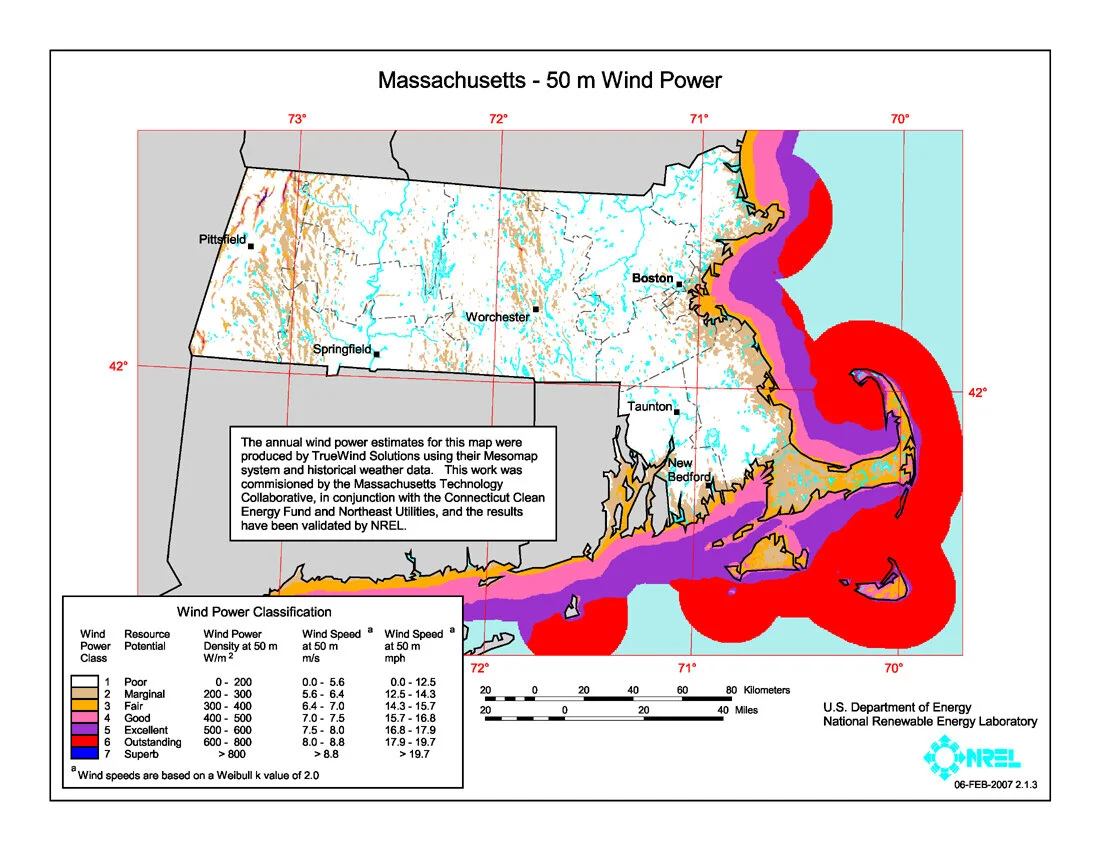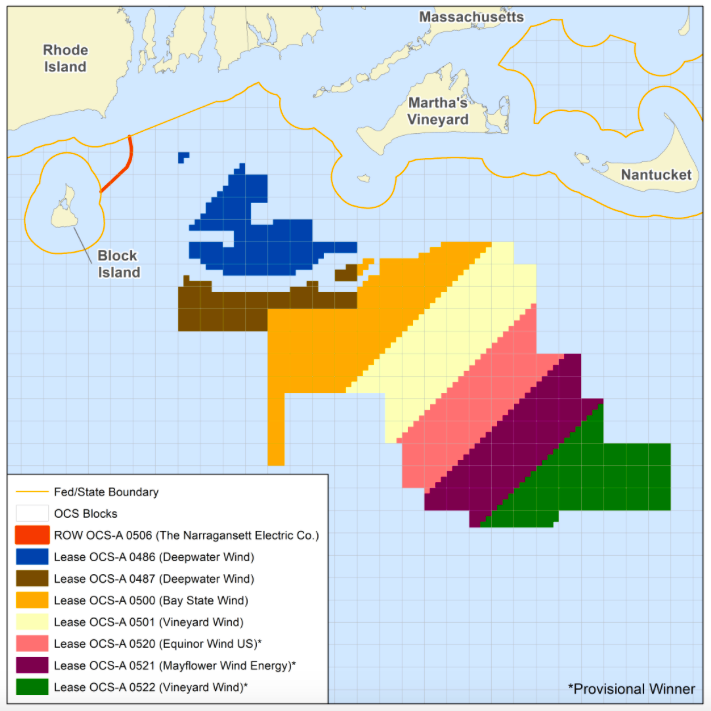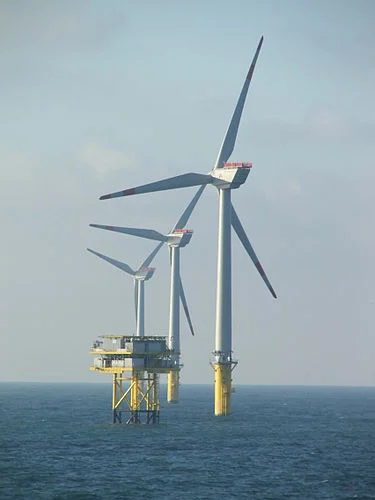
The fight for Mass. offshore wind goes on
From The New England Council (newenglandcouncil.com)
Orsted and Eversource have submitted a proposal to construct an wind energy farm off the Massachusetts coast. The proposed project, named Bay State Wind, includes a 400-megawatt project and an 800-megawatt project.
The companies’ proposal for Bay State Wind comes after Orsted’s federally approved offshore wind farm, Vineyard Wind, was put on hold for further review of its impact on fish and fisherman. Orsted, however, has been working closely with various commercial and local fisherman to accommodate their practices and projects in their own wind-turbine proposal. The companies said the project would bring hundreds of construction jobs to the state and, if selected, they plan to commit hundreds of millions of dollars to direct community investments.. Orsted and Eversource have worked together before, most recently on the Revolution Wind project planned for Rhode Island.
“We are thrilled to once again help Massachusetts take the next step to grow its clean energy economy,” said Lee Olivier, Eversource executive vice president for enterprise energy strategy and business development, in a statement. “Our team has been in the local communities, meeting with residents and stakeholders, to ensure their feedback is built into Bay State Wind’s proposal, which is the most mature, comprehensive and thorough offshore wind project available.”
Tim Faulkner: Offshore wind boom continues, with snags
From ecoRI News (ecori.org)
The demand for offshore wind continues, as the designated wind zones in waters south of Rhode Island, Martha’s Vineyard and Nantucket fill with projects.
At the June 11 meeting of the Rhode Island Coastal Resources Management Council (CRMC), Grover Fugate, executive director, recounted the growing pains to accommodate as much as 22,000 megawatts of offshore wind.
“This industry has literally exploded overnight,” said Fugate, as he highlighted issues confronting several projects.
The 800-megawatt Vineyard Wind facility, for instance, is deadlocked with the National Oceanic and Atmospheric Administration (NOAA) over the project’s environmental impact statement.
“That’s not something that’s been done before in the NEPA (National Environmental Policy Act) world,” Fugate said. “So we’re not quite sure where that is going to end up.”
The Nantucket Historical Commission is seeking $16 million from the Vineyard Wind developer, according to Fugate. The island town has sought funds to compensate for adverse visual impacts the 84 turbines may have on tourism.
Connecticut recently announced it wants to add 2,000 megawatts of offshore wind to the power grid but the state lacks approved offshore wind areas.
“Connecticut, of course, does not have any offshore sources,” Fugate said. “The closest ones to Connecticut are us (Rhode Island).”
Connecticut is already signed on for 300 megawatts from the Revolution Wind project located in one of four wind-lease areas that require CRMC approval.
Rhode Island has already signed up 400 megawatts from the same wind project managed jointly by Ørsted US Offshore Wind and the Massachusetts utility Eversource.
Massachusetts has a goal of 3,200 megawatts of offshore wind by 2035. It has already agreed to buy 800 megawatts from the Vineyard Wind project and the state has issued a request for proposal for an addition 800 megawatts that may come from the second half of the Vineyard Wind lease area.
Vineyard Wind went through a lengthy and contentious review for its initial wind facility and wants to meet with CRMC about a review of the second half of its wind-zone lease.
Bay State Wind, another Eversource and Ørsted project, is also moving forward with an 800-megawatt wind project in the same region. Fugate met with Bay State Wind’s CEO and discussed how the project fails to conform with a 1-mile spacing of turbines within its grid configuration.
Fugate said Bay State Wind is using a European design that doesn’t meet the fisheries requirement for U.S. projects.
“So they are taking that back under consideration,” Fugate said.
Vineyard Wind has filed a proposal to deliver 1.2 gigawatts of wind power to New York along a 95-mile transmission line from Vineyard Wind’s second wind zone, in the easternmost section of the federal wind-lease area. In all, New York is looking for some 9,000 megawatts of wind energy.
“If you add it all up it’s about 22,000 megawatts from New York to the Cape that's under consideration,” Fugate said.
He expressed frustration with the federal Bureau of Ocean Energy Management for not requiring an extended analysis of proposed offshore wind project sites.
“If you don't get two years of baseline data you have no way of measuring the impact,” Fugate said. “That may be intentional on their part, I don't know. But we have pushed for baseline data so that you can measure before and after, so that you know what you just did and how to adjust to it. But without that baseline, we don't know what we just did.”
Cable congestion
The surge in offshore wind development has created a need for transmissions lines and onshore connections to the electric grid. Wakefield, Mass.-based Anbaric Development Partners is creating a renewable-energy center on a leased site at the former Brayton Point coal-fired power plant in Somerset, Mass. Anbaric wants to install two high-voltage electric cables from Brayton Point to serve wind facilities off the coast of Massachusetts and Rhode Island. Ørsted would also like to run two cables from its Bay State Wind project to the mainland at Brayton Point.
The transmission lines would run through the the Sakonnet River along the easternmost channel of Narragansett Bay.
Fugate noted that the passage can only accommodate two power cables because of the narrow Stone Bridge corridor between Portsmouth and Tiverton. He said the activity at Brayton Point and other wind-facility operations within Narragansett Bay will be busiest during the summer, causing congestion along the East Passage, which runs between Newport and Jamestown.
“There’s a huge interference with a lot of existing uses down there,” Fugate said.
Federal review
NOAA officials will perform a three-day review of CRMC’s overall coastal program, including a public hearing scheduled for June 18. The review, required every seven years, will culminate with a report of findings that will offer suggested and required actions needed to adhere to federal grant requirements.
In a worst-case scenario, CRMC could face sanctions, which include a loss of federal funding for CRMC’s coastal programs. More than half of CRMC’s budget comes from federal sources.
NOAA’s last evaluation of CRMC was conducted in 2010.
The public hearing will be held at the Department of Administration building, conference room A, One Capital Hill, at 6 p.m.
Matunuck seawall
Hearings are expected in the fall for phase two of a seawall project on Matunuck Beach Road, in South Kingstown, R.I. The first phase was a highly controversial and meaningful case for the CRMC, as it confronts sea-level rise and shoreline erosion from climate change.
Tim Faulkner is an ecoRI News journalist.
Tim Faulkner: Will hurricanes imperil wind turbines off the Northeast?
Via ecoRI.org
As new offshore wind farms are built off the Northeast coast, a new report suggests that the current models of wind turbines may not withstand the most powerful of hurricanes. The study, by the University of Colorado Boulder, the National Center for Atmospheric Research and the U.S. Department of Energy, is intended to help the budding offshore wind industry as it expands into hurricane-prone regions, such as the East Coast.
“We wanted to understand the worst-case scenario for offshore wind turbines, and for hurricanes, that’s a Category 5,” said Rochelle Worsnop, lead author and a graduate researcher in the University of Colorado's Department of Atmospheric and Oceanic Sciences (ATOC).
Current design standards require offshore wind turbines be built to withstand 112-mph winds. Using computer-generated simulations, researchers found that portions of Category 5 hurricanes can reach up to 200 mph. Turbine blades also can be stressed by sudden and powerful shifts in wind direction, called veer.
Offshore wind turbines are typically larger than land-based turbines because components can be shipped over water instead of along size-restrictive railways and roads. The structures are therefore exposed to greater harm over their 20- to 30-year life, according to the report.
“Success could mean either building turbines that can survive these extreme conditions, or by understanding the overall risk so that risks can be mitigated, perhaps with financial instruments like insurance,” said Julie Lundquist, a co-author of the study and a professor at ATOC and the Renewable and Sustainable Energy Institute.
A subsequent study by the same group will look at the long-term effects of hurricanes on offshore wind farms built off the Atlantic Coast.
Rhode Island holds the honor of building the country’s first offshore wind farm, with the completion of the Block Island Wind Farm last November. The developer of the five-turbine, 30-megawatt wind farm, Providence-based Deepwater Wind, says the University of Colorado study is more relevant to the Southeast, where hurricane are more common and more powerful.
“Current offshore wind turbine designs are suitable for the wind conditions expected in the Northeast, where the strongest hurricane to make landfall in recorded history was a Category 3," Deepwater Wind spokeswoman Meaghan Wims said.
The most recent Category 3 hurricane to make landfall in New England was Hurricane Carol on Aug. 31, 1954. The storm had a sustained wind of 110 mph.
Deepwater Wind designs its turbines to withstand a 100-year storm, which has top wind speeds of 134 mph.
In the coming the decades, the company is planning to erect wind farms in the waters between Maryland and Maine.
“We don’t expect offshore wind energy to be deployed in the Southeast in the near term for other reasons — namely, a lower offshore wind resource than the Northeast,” Wims said.
Deepwater Wind and other developers have proposed multiple projects off of the wind-rich Northeast coast. Deepwater Wind is advancing a 15-turbine project, called South Fork Wind Farm, off eastern Long Island. Its Deepwater ONE project is slated for thousands of acres of federal waters between Massachusetts and Rhode Island. Vineyard Wind and DONG Energy, both based in Denmark, are also planning projects in the region. Bay State Wind, owned by DONG and Eversource Energy, intends to build several wind farms in the region.
But it’s only a matter of time before these wind turbines are tested by hurricanes. A report by the Union of Concerned Scientists says climate change, and warming oceans in particular, are making coastal storms more intense. Since the 1970s, the number of Category 4 and 5 hurricanes has almost doubled. Category 5 hurricanes have winds exceeding 157 mph; Category 4 winds blow between 130 and 156 mph; Category 3 winds are between 111 and 129 mph.
Tim Faulkner writes for ecoRI News.




